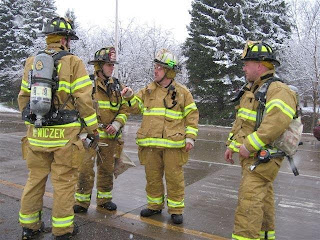 |
Example of a body camera worn by a police officer.
|
Departments must understand and inform their responders that “body cams” and “helmet cams” worn by any personnel while they are working are capturing government data regardless of who purchased the camera. As a consequence, the recordings must be maintained and released only in accordance with the Minnesota Data Practices Act and the records retention laws—or legal liability could result. Cities need to enact policies and procedures on how this new type of data is to be handled, and city personnel then need to be trained on the policy.
In 2006, two California Highway Patrol officers e-mailed their photographs of a 17-year old fatal traffic victim to acquaintances. The photos hit the web and went viral. In what has been called the “tragedy that will not fade,” the family began receiving these photos on their computer at home with messages that read “I’m not dead yet.” The family had to disconnect all access to the internet. After years of litigation and appeals, the family recently reached a settlement for $2.37 million.
The technology is already here, leaving cities to grapple with how to deal with it. The addition of the video camera in the squad car opened a new window to police work.
Recently, the Burnsville Police Department transitioned to a body camera system where a camera is worn by the officer. The video captures the domestic abuse suspect and victim as the officers arrives; it captures the bar fight, and the fleeing suspect. Importantly, a large component of the Burnsville camera system is the data storage, retention, and maintaining of the data as evidence.
 |
Burnsville PD vehicles are outfitted with cameras.
|
Some want to document their actions but work for departments that cannot afford a city-owned system. Understandably, they want the protection that a camera and recording provide them, as every night they confront people who do not tell the truth the next day. Surprisingly, though, some of these videos are also showing up on social media sites.
When a city employee or volunteer acts on their own to purchase and use a body cam, they need to be aware that it creates both legal and practical concerns over how the data is maintained and shared with the public (if at all). The League of Minnesota Cities Insurance Trust (LMCIT) recommends that cities proactively develop and enforce policies to prohibit the use or wearing of personal audio and video recording devices while working unless the devices and recordings are used and maintained in accordance with a thoughtfully developed department policy that complies with records retention and privacy laws.
Being proactive will protect both the city and its employees and volunteers—who may simply not be aware of the legal requirements cities face related to data, or the big-picture ramifications of their actions.
Remember:
Responder Safety = Public Safety
Up next time: “PTSD—Post-Traumatic Stress Disorder”
In the meantime, stay safe and be careful.
Rob





















